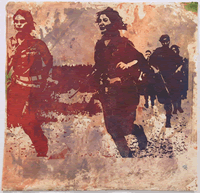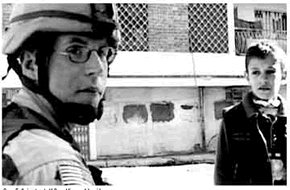All who draw the sword will die by the sword. -- Yeshua Ha-Notsri, Palestinian dissident, c. 33 CE. As we all know – or rather, as everyone but those who climb and claw their way to the top of power's greasy pole knows – the effects of war are vast, unforeseeable, long-lasting -- and uncontrollable. The far-reaching ripples of the turbulence will churn against distant shores and hidden corners, then roil back upon you in ways you could never imagine, for generations, even centuries.
As we all know – or rather, as everyone but those who climb and claw their way to the top of power's greasy pole knows – the effects of war are vast, unforeseeable, long-lasting -- and uncontrollable. The far-reaching ripples of the turbulence will churn against distant shores and hidden corners, then roil back upon you in ways you could never imagine, for generations, even centuries.
Nor is "victory" in war proof against these deleterious effects. For the brutalization, moral coarsening, corruption and concentration of elite power that attend every war do not simply disappear from a society when the fighting stops. They persist, like microbes, in myriad forms, working with slow, corrosive force to degrade and deform the victors. Indeed, victory in battle often leads a society to enshrine war's most pernicious attributes: violence is ennobled, and becomes entrenched as an ever-ready instrument of national policy. Militarism is exalted, the way of peace dishonored: cries of "Appeasers! Cowards! Traitors!" greet every approach that fails to brandish the threat of extreme violence, that fails to "keep all options on the table."
The apparent "lesson" of victory – that there can be no right without armed might to win and safeguard it – quickly degenerates into the belief that armed might is right. (William Astore has an excellent article here on how the collision with Nazi Germany infected America's military with a continuing admiration for the German war machine.) Military power becomes equated with moral worth, and the ability to wreak savage, unimaginable destruction through armed violence -- via thoughtless obedience to the orders of "superiors" – becomes a cherished attribute of society.
War is no longer seen as a vast, horrific failure of the human spirit, a scandalous betrayal of our common humanity, a sickening tragedy of irrevocable loss and inconsolable suffering – although this is its inescapable reality, even in a "good" war, for a "just" cause. (And of course no nation or faction has ever gone to war without declaring that its cause is just.) Instead of lamenting war, and girding for it, if at all, only in the most dire circumstances, with the most extreme reluctance, the infected society celebrates it at every turn. No national occasion – even a sporting event! – is complete without bristling displays of military firepower, and pious tributes to those wreaking violence around the world in blind obedience to their superiors.
Oddly enough, when a modern nation consciously adopts a "warrior ethos," it casts aside -- openly, even gleefully -- whatever virtue that ethos has historically claimed for itself, such as courage in battle and honor toward adversaries. In its place come the adulation of overwhelming technological firepower and the rabid demonization of the enemy (or the perceived enemy, or even the "suspected" enemy), who is stripped of all rights, all human dignity, and subject to "whatever it takes" to break him down or destroy him.
Thus our American militarists exult in the advanced hardware that allows "soldiers" to slaughter people from thousands of miles away, with missiles, bombs and bullets fired from lurking, unreachable drones high in the sky. (A recent study shows that even by the most conservative reckoning of who is or isn't a "militant," at least one third of the hundreds killed in the Bush-Obama drone campaigns in Pakistan are clearly civilians.) The drone "warriors" -- often living in complete safety and comfort -- see nothing but a bloodless image on a screen; they face no physical threat at all. This is assassination, not combat; it reeks of cowardice, and dehumanizes everyone it touches, the victims and the button-pushers alike. Yet our militarists -- most of whom, of course, have somehow never found the time to fight the wars they cheer for -- wax orgasmic about this craven weaponry. In the transvaluation of values that militarism produces, cowardice becomes a martial virtue.
Source:http://www.chris-floyd.com/component/content/article/1-latest-news/1937-unnatural-acts-breaking-the-fever-of-militarism.html
The Impact of War on Women and Children
In the name of such euphemisms as sovereignty, democracy, freedom and liberation, armies everywhere, most notably those who act at the behest of the U.S. military-industrial complex, are exacting a deadly cost. Militarism everywhere is out of control, cutting a violent swath of pandemic proportions across our planet. Women and children account for almost 80% of the casualties of conflict and war as well as 80% of the 40 million people in world who are now refugees from their homes. It is one of the unspoken facts of militarism that women often become the spoils of war, their deaths are considered collateral damage and their bodies are frequently used as battlegrounds and as commodities that can be traded.
"Women and girls are not just killed, they are raped, sexually attacked, mutilated and humiliated. Custom, culture and religion have built an image of women as bearing the 'honour' of their communities. Disparaging a woman's sexuality and destroying her physical integrity have become a means by which to terrorize, demean and 'defeat' entire communities, as well as to punish, intimidate and humiliate women," according to Irene Khan of Amnesty International.
Sexual violence as a tool of war has left hundreds of thousands of women raped, brutalized, impregnated and infected with HIV/AIDS. And hundreds of thousands of women are trafficked annually for forced labor and sexual slavery. Much of this trafficking is to service western troops in brothels near military bases. Even women serving in the military are subjected to sexual violence. U.S. servicewomen have reported hundreds of assaults in military academies and while serving on active duty. The perpetrators of these assaults have rarely been prosecuted or punished.
The impact of war on children is also profound. In the last decade, two million of our children have been killed in wars and conflicts. 4.5 million children have been disabled and 12 million have been left homeless. Today there are 300,000 child soldiers, including many girls who are forced to 'service' the troops.
Environmental damage is another de facto weapon of war that has dire consequences. The Pentagon makes no secret that it uses nuclear and chemical weaponry such as depleted uranium and napalm. We know that the cancer rate and number of birth defects in Iraq have soared since the first Gulf War. Perversely, not only are we poisoning the 'enemy' but continuing in the tradition of Agent Orange in Vietnam and Gulf War Syndrome, our own soldiers are also being exposed to the effects of this weaponry. There is little doubt that they also face higher cancer and disease rates as well as offspring born with birth defects.
Shoddy disposal of military toxins also impacts our health by polluting our water, land and air. Most recently, the U.S. military has been disposing of perchlorate, (a rocket fuel) in such a way that it is getting into our groundwater (affecting the drinking water of 20 million people) and our food as well as in the breastmilk of nursing mothers. It is also likely that perchlorate impacts reproductive health.
Disproportionate spending on war-making comes at the expense of funding for programs that benefit our lives and our planet. For example, a community near where I live recently announced that it had lost its funding for helping victims of domestic violence, an all too common occurrence as funding for combating violence against women is diverted to fund Homeland Security. In doing so, we place the lives of thousands of women at risk of harm. (Ironically, there seems to be plenty of money to train TSA airport screeners to grope women's breasts.) And in Afghanistan, a mere $72.5 million (less than 3%) of reconstruction funds has been spent on programs to benefit women , in sharp contrast to the hundreds of billions spent on death and destruction in both Afghanistan and Iraq.
The monstrous scope of this carnage and its impact on women and children make it quite clear that what is occurring is a systemic fact of militarism and the patriarchy it defends. The cavalier usurpation of our lives in the name of empire imperils us all. The ongoing violence towards and poisoning of our bodies is more terrifying than the terror we purport to fight. We can no longer afford the violence implicit in empire at any cost. War against mythical terrors creates the reality of our own demise.
Source: http://www.commondreams.org/views04/1219-26.htm
The Impact of Militarism on the Environment
Even in the absence of war, military establishments consume massive amounts of environmental and human resources.
Compared with the civilian sector, the military "uses more than its proportional share of rare and expensive, and often dangerous raw materials" according to the International Study Team's report, "Health and Welfare in Iraq." The armed forces also deplete vast amounts of energy.
Worldwide, military activities use large tracts of land and airspace. In its ongoing work, global militarism has at its disposal a significant portion of the world's human and financial resources. The development of the military sector of the economy takes place at the expense of the civilian sector.
Energy and Materials
Most of the data available on the military's consumption of energy and materials comes from the United States. Indeed, with a military machine of unparalleled proportions, it is not surprising that the U.S. armed forces consume astronomical quantities of energy and materials.
The Pentagon is considered the single largest domestic consumer of oil. It is very likely the largest worldwide. The Department of Defense purchased 2(X) billion barrels of oil for military use in 1989-enough to run all of the U.S. public transit systems in the U.S. for 22 years.
In less than one hour an F-16 consumes almost twice as much gas as the average American motorist during one year. A modern battle tank's fuel consumption is so high that it can be measured in gallons per mile. From 5 10 15 % of the U.S. non-fuel minerals are used by the Pentagon.
The global statistics on the militarism's consumption of energy and materials are equally sobering:
- Approximately one quarter (42 million tons per year) or the world's jet fuel is used by armed forces.
- nine percent of global iron and steel is consumed by armed forces.
- The worldwide military use of aluminum, copper, nickel and platinum is greater than the entire Third World's demand for these materials.
Land Use
Globally, between 750,000 and 1.5 million square kilometres of land are controlled by armed forces. This does not include the area occupied by arms producing companies.
Michael Renner reports that in recent years more and more land has been turned over to armed forces and consequently withdrawn from public access. Military requirements for land have increased over the past century due to "the increase in the size of standing armed forces and, more particularly, the rapid pace of technological advances in weaponry."
With its choreographed violence, the military destroys large tracts of land it is supposed to protect. Land used for war games is prone to suffer severe degradation. Manoeuvres demolish natural vegetation, disturb wildlife habitat, erode and compact soil, silt up streams, and cause flooding. Bombing ranges transform the land into a moon-like wasteland, pockmarked with craters. Shooting ranges for tanks and artillery contaminate soil and groundwater with lead and other toxic residues.
- In the United States, approximately 100,000 square kilometers or the equivalent or the entire state of Virginia are allocated to military use.
- Outside its own borders, the U.S. military controls about 8,100 square kilometres.
- In 1991 the Soviet military apparatus controlled approximately 200,000 square kilometres.
- Over 40 years of the world's largest troops concentration all along the inner German border contributed to serious environmental stress.
Recovery from the effects of some military activities may take thousands of years. Nuclear test sites suffer from contamination that is almost permanent. Some production and testing sites used by the military are rendered completely unusable. For example:
- In 1989, the U.S. Army's Jefferson Proving Ground, in Indiana, was closed because it is polluted with over 6.9 million buried bombs and shells. Clean-up is considered too dangerous and prohibitively expensive.
- In the former Soviet Union, Lake Karachay has become so polluted with radioactive wastes that simply standing along its shore for an hour would be lethal.
Airspace and Atmospheric Pollution
The world's armed forces have even more access to airspace than to land. Military activities have greatly contributed to problems such as air pollution and ozone depletion.
In former West Germany, almost the entire airspace was open to military jets and two-thirds of it to low level flights. Most recent reports state that there were between 700,0000 and one million sorties per year. West German armed forces jets accounted for 58% of air pollutants generated by all air traffic over its territory.
As much as 70% of all airspace is used for military purposes in the United States. The majority of the military flights take place over the Western U.S.A. There are approximately 90,000 training sorties per year. One- fifth of these are at very low levels.
Canada has one of the world's most extensive airspaces for military purposes. Over 100,000 square kilometres are assigned to the Goose Bay Air Base in Labrador. By 1992, the number of low-level sorties flown by Canadian and other NATO jets is projected to increase from 6,656 to 8,400. In Alberta and Saskatchewan, the Cold Lake Air Weapons Range stretches over 450,000 square kilometres of flying area.
One of the most serious effects of military use of airspace results from low-level flights, which disrupt wildlife migrations and behavioural patterns. Human health is also affected: Supersonic "booms" occurring in low-level flights can lead to hearing loss, high blood pressure, disturbance of the intestinal tract and other organs as well as psychological trauma.
In North America, native communities are the most severely affected. In Canada, the Ilnnu of Nitassinan (Labrador) have repeatedly complained to the Canadian government, but the number of flights is increasing over the land. In the U.S. flight training takes place over 14 Native American nations.
Lack of data on atmospheric pollution means that estimates are rough. However, German environmentalist Gunar Seitz estimates that 6 to 10% of global air pollution can be linked to armed forces operations. According to the Worldwatch Institute's research, the total release of carbon dioxide as a result or military activity could be as high as 10 per-cent or total global emissions. One military contractor, General Dynamics (makers of the F-16) uses 500,000 pounds of CFC-113 yearly.
The U.S. military is responsible for half of the worldwide use of CFC-113. the Department of Defense is a major user of Halon 1211 and CVC-113, which account for 13 percent of overall ozone depletion.
According to John O'Connor of the National Toxics Campaign, the world's military forces are responsible for the release of more than two-thirds of CFC-113 into the ozone layer.
The military also uses ozone-depleting substances that have no civilian counterpart. The B-2 Stealth bomber, for example, uses a fuel additive that is a known ozone depleter but of unknown potency.
Ozone depletion is increasingly being linked to serious health problems such as skin cancer, cataracts, and a number of diseases affected by immunosuppression, such as the AIDS virus.
Human and Financial Resource Depletion
The environmental costs of militarism are compounded by the lost opportunities resulting from the annual diversion of almost $1 trillion in global resources for military purposes. Between 1960 and 1990, world military spending added up to 21 trillion dollars.
In the U.S., government spending for military Research and Development exceeds that for all civilian needs combined. Thus, such important sectors as environmental protection, alternative energy sources and energy efficiency are shortchanged.
Ruth Leger Sivard, author of the yearly World Military and Social Expenditures report, draws attention to the distorting effects that heavy military spending has had on the global economy. The enormous sums invested in arms and armies do not provide an economic foundation for development progress. By diverting capital research facilities and manpower from civilian enterprise, these expenditures slow productivity gains and stimulate inflation. Fora developed country the result can be a gradual erosion of competitive status in the international market. For a fragile developing country, it can be a quick route to bankruptcy.
World military research and development expenditures continue to grow at twice the rate of military expenditures as a whole. Yet there is a lack of funds for monitoring global climatic change, surveying disappearing rainforests and spreading deserts, and for developing agricultural technologies for rain-fed tropical regions.
Military research and development "impairs a country's innovative capacity by drawing scientific talent away from the civilian sector," according to Renner.
Over 20% of all scientists and engineers in the world are employed by the military sector. World military research and development expenditures rose from $13 billion per year in 1960 to $100 billion in 1986.
According to Brundtland: "Half a million scientists are employed on weapons research worldwide, and they account for around half of all research and development expenditure. This exceeds the total combined spending on developing technologies for new energy sources, improving human health, raising agricultural productivity, and controlling pollution."
Source: http//:www.peacemagazine.org/archive/v08n3p08.htm


 In 2007, the world spent approximately $1.1 trillion on military expenditure - for making weapons and training people to kill, rather than for creating a better and sustainable world for all. An enormous amount of skills, resources, and energies go towards developing better killing machines and weapons and supporting the military-industrial complex, instead of going towards the betterment of society and the planet.
In 2007, the world spent approximately $1.1 trillion on military expenditure - for making weapons and training people to kill, rather than for creating a better and sustainable world for all. An enormous amount of skills, resources, and energies go towards developing better killing machines and weapons and supporting the military-industrial complex, instead of going towards the betterment of society and the planet. Old soldiers in the Civil War coined a phrase for green troops who survived their first taste of battle: "He has seen the elephant." This Army lieutenant sums up the combat experience better than many a grizzled veteran:
Old soldiers in the Civil War coined a phrase for green troops who survived their first taste of battle: "He has seen the elephant." This Army lieutenant sums up the combat experience better than many a grizzled veteran: Currently, serving in the military can reduce the time before you can apply to become a U.S. citizen. Normally you have to be a permanent resident for at least five years or three years if you are married to a U.S. citizen. Serving in the military does not guarantee U.S. citizenship and it is not automatic. The military cannot guarantee or promise that you would become a citizen by serving. IF you are non-citizen, you should talk to an immigration lawyer before sign an enlistment contract. You do not want to serve in the military for years, only to find out that you cannot gain citizenship or residency after all. Also, there is no law in the U.S. that requires to join the military. You cannot be deported or denied citizenship simply because you choose not to enlist.
Currently, serving in the military can reduce the time before you can apply to become a U.S. citizen. Normally you have to be a permanent resident for at least five years or three years if you are married to a U.S. citizen. Serving in the military does not guarantee U.S. citizenship and it is not automatic. The military cannot guarantee or promise that you would become a citizen by serving. IF you are non-citizen, you should talk to an immigration lawyer before sign an enlistment contract. You do not want to serve in the military for years, only to find out that you cannot gain citizenship or residency after all. Also, there is no law in the U.S. that requires to join the military. You cannot be deported or denied citizenship simply because you choose not to enlist. Activists in Humboldt County, California, in 2007, had experimented with a different approach to regulating military recruitment: a city ordinance introduced via citizen initiative.
Activists in Humboldt County, California, in 2007, had experimented with a different approach to regulating military recruitment: a city ordinance introduced via citizen initiative.
 The warning, given to me 25 years ago, came at the moment Pat Robertson and other radio and televangelists began speaking about a new political religion that would direct its efforts at taking control of all institutions, including mainstream denominations and the government. Its stated goal was to use the United States to create a global, Christian empire. It was hard, at the time, to take such fantastic rhetoric seriously, especially given the buffoonish quality of those who expounded it. But Adams warned us against the blindness caused by intellectual snobbery. The Nazis, he said, were not going to return with swastikas and brown shirts. Their ideological inheritors had found a mask for fascism in the pages of the Bible. - Chris Hedges (From his article:
The warning, given to me 25 years ago, came at the moment Pat Robertson and other radio and televangelists began speaking about a new political religion that would direct its efforts at taking control of all institutions, including mainstream denominations and the government. Its stated goal was to use the United States to create a global, Christian empire. It was hard, at the time, to take such fantastic rhetoric seriously, especially given the buffoonish quality of those who expounded it. But Adams warned us against the blindness caused by intellectual snobbery. The Nazis, he said, were not going to return with swastikas and brown shirts. Their ideological inheritors had found a mask for fascism in the pages of the Bible. - Chris Hedges (From his article: 



 David Swanson is the author of the new book, Daybreak: Undoing the Imperial Presidency and Forming a More Perfect Union, by Seven Stories Press and of the introduction to The 35 Articles of Impeachment and the Case for Prosecuting George W. Bush by Dennis Kucinich. In addition to cofounding AfterDowningStreet.org, he is the Washington director of Democrats.com and sits on the boards of a number of progressive organizations in Washington, DC.
David Swanson is the author of the new book, Daybreak: Undoing the Imperial Presidency and Forming a More Perfect Union, by Seven Stories Press and of the introduction to The 35 Articles of Impeachment and the Case for Prosecuting George W. Bush by Dennis Kucinich. In addition to cofounding AfterDowningStreet.org, he is the Washington director of Democrats.com and sits on the boards of a number of progressive organizations in Washington, DC. Jorge Mariscal is the grandson of Mexican immigrants and the son of a U.S. Marine who fought in World War II. He served in the U.S. Army in Vietnam and currently teaches at the University of California, San Diego.
Jorge Mariscal is the grandson of Mexican immigrants and the son of a U.S. Marine who fought in World War II. He served in the U.S. Army in Vietnam and currently teaches at the University of California, San Diego. Matt Guynn plays the dual role of program director and coordinator for congregational organizing for On Earth Peace, building peace and nonviolence leadership within the 1000+ congregations of the Church of the Brethren across the United States and Puerto Rico. He previously served a co-coordinator of training for Christian Peacemaker Teams, serving as an unarmed accompanier with political refugees in Chiapas, Mexico, and offering or supporting trainings in the US and Mexico.
Matt Guynn plays the dual role of program director and coordinator for congregational organizing for On Earth Peace, building peace and nonviolence leadership within the 1000+ congregations of the Church of the Brethren across the United States and Puerto Rico. He previously served a co-coordinator of training for Christian Peacemaker Teams, serving as an unarmed accompanier with political refugees in Chiapas, Mexico, and offering or supporting trainings in the US and Mexico. Rick Jahnkow works for two San Diego-based anti-militarist organizations, the Project on Youth and Non-Military Opportunities and the Committee Opposed to Militarism and the Draft. He can be reached at:
Rick Jahnkow works for two San Diego-based anti-militarist organizations, the Project on Youth and Non-Military Opportunities and the Committee Opposed to Militarism and the Draft. He can be reached at:  Pat Elder was a co-founder of the
Pat Elder was a co-founder of the 
 Edward Hasbrouck grew up in Wellesley, Massachusetts, a suburb of Boston. He considers myself primarily a political activist. Hasbrouck began his resistance to the violence of illegitimate authority as an elected but nonvoting student representative to the local school board and as an activist for peace, disarmament, and students' rights. His first book was a handbook for high school students on their legal rights co-authored in the summer of 1977, between high school and college, as an intern for the student service bureau of the Massachusetts Department of Education. He majored in political science at the University of Chicago until leaving school to pursue direct involvement in political activism.
Edward Hasbrouck grew up in Wellesley, Massachusetts, a suburb of Boston. He considers myself primarily a political activist. Hasbrouck began his resistance to the violence of illegitimate authority as an elected but nonvoting student representative to the local school board and as an activist for peace, disarmament, and students' rights. His first book was a handbook for high school students on their legal rights co-authored in the summer of 1977, between high school and college, as an intern for the student service bureau of the Massachusetts Department of Education. He majored in political science at the University of Chicago until leaving school to pursue direct involvement in political activism.




